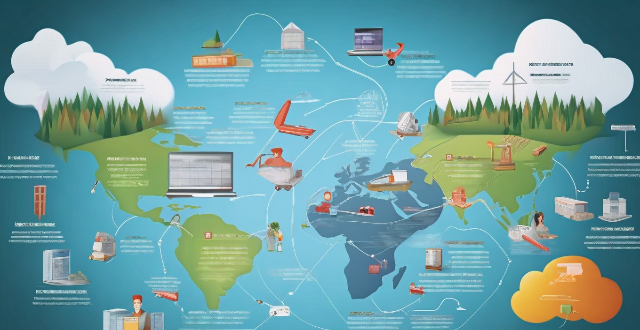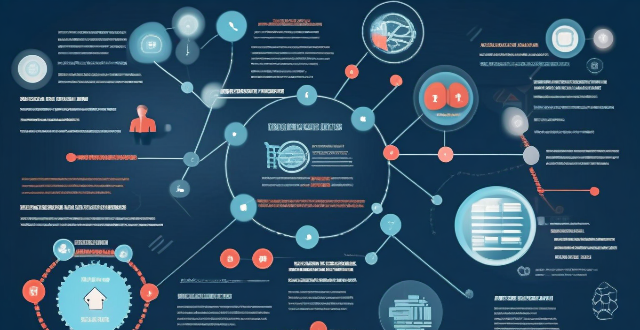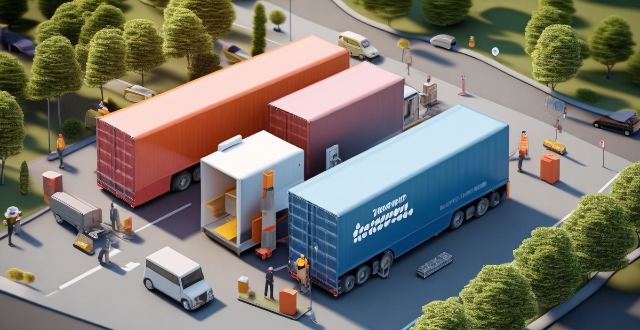Chain Infrastructure

What are the economic implications of investing in climate-resilient supply chain infrastructure ?
This article explores the various economic implications of investing in climate-resilient supply chain infrastructure. It highlights how such investments can lead to cost savings, increased productivity and efficiency, improved insurance rates, enhanced supply chain visibility, and competitive advantage. The article also emphasizes the importance of building a strong brand reputation and accessing new markets through sustainable and resilient practices. Overall, it underscores the significance of prioritizing investments in climate-resilient supply chain infrastructure for businesses and economies around the world.

What are some best practices for managing risk associated with climate change in a global supply chain ?
This article outlines best practices for managing risk associated with climate change in a global supply chain. It suggests assessing climate change risks by identifying potential impacts and evaluating vulnerabilities, developing a risk management plan that includes setting clear objectives and implementing mitigation measures, and monitoring and reviewing performance through tracking progress against objectives and continuously improving strategies. Key strategies include diversifying supplier networks, investing in resilient infrastructure, improving energy efficiency, enhancing supply chain transparency, promoting sustainable practices, establishing regular reporting processes, benchmarking against industry standards, soliciting stakeholder feedback, revising risk management plans regularly, participating in collaborative learning opportunities, and fostering a culture of innovation within the organization.

How can smart contracts improve supply chain management ?
Smart contracts can revolutionize supply chain management by automating transactions, enhancing transparency, improving efficiency, enabling real-time tracking, and reducing risks. This decentralized and automated approach can save time, reduce costs, prevent fraud, and improve overall trust between parties in the supply chain.

How can blockchain solve the issue of supply chain management ?
Blockchain technology can revolutionize supply chain management by addressing various challenges faced by businesses. It improves visibility and traceability, reduces paperwork and manual processes, streamlines payment processes, enhances data security, and builds trust among stakeholders. With its potential to solve many of the issues faced by businesses in supply chain management, blockchain is an ideal solution for modern supply chains.

What are the benefits of staying at a small, boutique luxury hotel versus a larger chain resort ?
Staying at a small, boutique luxury hotel offers several advantages compared to a larger chain resort, including personalized service, unique ambiance, a quieter environment, local flavor, and exclusivity.

What policies and regulations are currently in place to encourage more sustainable supply chain practices ?
Policies and Regulations Encouraging Sustainable Supply Chain Practices discusses various government initiatives, industry standards, and international agreements that promote sustainable supply chain practices. Government policies such as green procurement, carbon pricing, and eco-labels incentivize businesses to adopt environmentally friendly operations. Industry standards like CSR and LCA help companies understand and reduce their ecological footprint. International treaties like the Paris Agreement and Basel Convention provide a global framework for sustainable practices. Together, these measures form a comprehensive system to support sustainable supply chains worldwide.

What is the role of consumers in driving more sustainable supply chain practices through their purchasing decisions ?
Consumers play a crucial role in driving more sustainable supply chain practices through their purchasing decisions. By choosing products that are produced using environmentally friendly and socially responsible methods, consumers can influence companies to adopt more sustainable practices throughout their supply chains. This can lead to reduced carbon emissions, improved working conditions, and better resource management. The key points include education and awareness, green consumerism, supplier selection, product design, brand loyalty, public pressure, regulatory influence, investor interest, innovation, and collaboration.

In what ways can businesses engage in sustainable supply chain management as a key component of their CSR programs ?
The text discusses the importance of sustainable supply chain management in corporate social responsibility (CSR) programs. It emphasizes setting clear objectives and goals, conducting supplier audits and assessments, collaborating with suppliers, measuring performance and reporting results, and continuously improving and innovating as key steps in sustainable supply chain management. The text suggests that these practices can help businesses demonstrate their commitment to sustainability while also improving their bottom line.

How has the COVID-19 pandemic highlighted the importance of resilient supply chain management in the face of climate-related disruptions ?
The text discusses the impact of the COVID-19 pandemic on supply chain management and emphasizes the importance of resilient supply chain management to withstand future climate-related disruptions. The pandemic caused significant disruptions in the global supply chain, including disruption of global trade, bottlenecks, shortage of raw materials, and labor shortages. A resilient supply chain is adaptable, diversified, collaborative, and leverages technology to improve efficiency, reduce waste, and increase transparency. These characteristics ensure that the supply chain can withstand not only the current crisis but also future climate-related disruptions.

How do geopolitical factors influence the sustainability efforts of global supply chains ?
Geopolitical factors significantly influence sustainability efforts in global supply chains by affecting trade policies, political stability, resource control, infrastructure development, and cultural attitudes towards sustainability. These elements determine the costs, efficiency, and environmental impact of global production networks. Understanding these dynamics is vital for businesses aiming to build resilient and sustainable supply chain operations.

How does climate change affect global supply chain management ?
Climate change affects various aspects of life, including global supply chain management. Extreme weather events, rising sea levels, changes in agricultural production, energy costs, and labor availability are some ways in which climate change impacts this crucial aspect of business operations. Businesses must adapt their strategies to mitigate these risks and ensure the continued efficiency and effectiveness of their operations.

What types of infrastructure are needed to support widespread use of electric vehicles ?
The widespread adoption of electric vehicles necessitates the development and expansion of various types of infrastructure to support their charging needs, including public and residential charging stations, energy infrastructure, information systems, maintenance and support services, and urban planning and design.

How do government policies influence the growth of electric vehicle infrastructure ?
Government policies play a crucial role in shaping the growth of electric vehicle (EV) infrastructure. These policies can be broadly categorized into regulatory, financial, and informational measures. Regulatory policies set standards and mandates that must be followed by businesses and consumers, while financial incentives and disincentives are powerful tools used by governments to encourage the adoption and expansion of EV infrastructure. Information plays a vital role in shaping consumer behavior and market dynamics, with governments leveraging this by providing relevant data and promoting awareness. In conclusion, government policies across regulatory, financial, and informational domains have a profound impact on the growth of electric vehicle infrastructure.

How does the availability of electric vehicle infrastructure impact the environmental benefits of EVs ?
Electric vehicle infrastructure plays a pivotal role in maximizing environmental benefits. Adequate charging networks reduce range anxiety, increase EV usage, and support optimal charging times for minimal carbon footprints. Renewable energy integration through solar and wind power further enhances green initiatives. Smart urban planning and design facilitate seamless EV adoption, while consumer behavior shifts with improved infrastructure, promoting eco-friendly habits. The development of robust and innovative EV infrastructure is crucial to fully realize the environmental potential of electric vehicles.

What is the current state of electric vehicle infrastructure in major cities ?
The current state of electric vehicle (EV) infrastructure in major cities varies significantly depending on the region and local government policies. However, there are some common trends and challenges that can be observed across different urban areas. One of the most important aspects of EV infrastructure is the availability of charging stations. In many major cities, the number of public charging stations has increased rapidly in recent years, but they are still not as widespread as gas stations for traditional vehicles. This can make it difficult for EV owners to find a convenient place to charge their vehicles, especially if they live in apartment buildings without dedicated parking spots or garages. Another key factor is the speed at which EVs can be charged. While most EVs come with standard Level 1 or Level 2 charging capabilities, which take several hours to fully charge the battery, more advanced fast charging technology is becoming increasingly available. These fast chargers can replenish an EV's battery much more quickly, making them ideal for road trips or long-distance travel. However, the availability of fast chargers is still limited in many cities, and they tend to be concentrated along major highways rather than in urban areas. The cost of charging an EV can also vary widely depending on location and time of day. In some cities, public charging stations may offer free or discounted rates during off-peak hours to encourage EV adoption. However, these incentives are not always available, and some drivers may find that the cost of charging their EV is higher than expected, especially if they rely heavily on public charging stations. Finally, the accessibility and usability of EV infrastructure is another important consideration. Some cities have made significant investments in building out their EV infrastructure, including installing dedicated EV parking spots and providing real-time information about available charging stations through smartphone apps. However, other cities may still lag behind in terms of accessibility and usability, making it more difficult for EV owners to take full advantage of their vehicles' capabilities.

What is the significance of green infrastructure in managing urban runoff and improving water quality ?
Green infrastructure (GI) is a sustainable approach that uses natural processes to manage stormwater, reduce pollution, and enhance the overall health of urban ecosystems. It plays a crucial role in managing urban runoff and improving water quality. Some benefits of GI include reducing stormwater runoff, improving water quality, enhancing habitat and biodiversity, and mitigating climate change impacts. To effectively implement green infrastructure in urban areas, factors such as site selection, design considerations, and maintenance and management should be considered. Proper maintenance and management are essential for ensuring the long-term success of green infrastructure projects. By implementing effective green infrastructure practices, cities can create healthier, more resilient environments for both people and wildlife.

How does extreme weather impact energy infrastructure and what measures can be taken to improve resilience ?
The impact of extreme weather on energy infrastructure is significant, causing damage to power plants, transmission lines, and distribution systems. This can lead to power outages, fuel supply disruptions, infrastructure degradation, increased maintenance costs, and environmental concerns. To mitigate these impacts, proactive measures such as strengthening infrastructure, diversifying energy sources, upgrading technology, preparing for emergencies, and investing in microgrids can be taken. Reactive measures include rapid repair and recovery, emergency response teams, communication systems, insurance and financial aid, and lessons learned from each event. By implementing these measures, the resilience of energy infrastructure can be improved, minimizing negative impacts on society and the economy.

How does the development of electric vehicle infrastructure affect the adoption rate of EVs ?
The development of electric vehicle infrastructure, including charging stations and supporting technologies, significantly influences the adoption rate of EVs. Availability and accessibility of charging stations are critical factors affecting EV adoption rates. Increased availability and reduced range anxiety can lead to higher demand for EVs and boost their adoption rate. Easy-to-find and accessible charging stations make it easier for potential EV owners to plan their trips and charge their vehicles as needed. The cost of charging an EV also affects its adoption rate, with affordable pricing and transparent pricing information encouraging more people to adopt EVs. Overall, the growth of electric vehicle infrastructure is crucial in determining the adoption rate of EVs.

What strategies can urban planners employ to create more resilient sports infrastructure in the face of climate change ?
The article discusses strategies for creating resilient sports infrastructure in the face of climate change. These include conducting thorough climate risk assessments, incorporating green infrastructure, designing for flexibility and adaptability, ensuring energy efficiency and sustainability, strengthening infrastructure, improving water management, planning for long-term maintenance and upkeep, and engaging stakeholders and promoting community awareness.

How can blockchain technology improve supply chain management in transportation ?
Blockchain technology can improve supply chain management in transportation by providing enhanced transparency, increased efficiency, improved security, and greater collaboration. This can lead to reduced costs, faster dispute resolution, and improved customer satisfaction. Blockchain allows for real-time tracking of goods, shared data access, automated processes, and reduced paperwork. It also ensures data integrity, builds trust among parties, and helps mitigate risks. By encouraging collaboration and open standards, blockchain promotes innovative solutions that can further improve supply chain management in transportation.

What challenges are faced in achieving equal vaccine access ?
The text discusses the challenges in achieving equal vaccine access, which include global inequality, limited manufacturing capacity, logistical hurdles, information gap, and financial constraints. These challenges are influenced by political, economic, geographical, and cultural factors, as well as infrastructure deficits and funding shortfalls. To address these challenges, coordinated international efforts, increased funding, improved infrastructure, effective communication strategies, and equitable distribution mechanisms are needed.

How can blockchain technology be used in supply chain management ?
Blockchain technology is poised to revolutionize supply chain management by offering transparency, traceability, and security. Smart contracts automate transactions, while secure data sharing promotes collaboration. The technology also reduces manual processes, paperwork, and enhances compliance.

What role do technology and innovation play in improving sustainability within supply chain management ?
Technology and innovation are crucial for enhancing sustainability in supply chain management. They enable real-time monitoring, process optimization, energy efficiency, waste reduction, and transparency. By adopting these advancements, businesses can create environmentally friendly operations while maintaining profitability.

What is the significance of traceability in the food supply chain for food safety ?
Traceability in the food supply chain is crucial for food safety, enhancing transparency, facilitating recalls, improving quality control, supporting regulatory compliance, enabling better risk management, and promoting sustainable practices.

Can you explain how blockchain technology works and its potential applications ?
Blockchain technology is a decentralized, digital ledger that records transactions in a secure and transparent manner. It works through a peer-to-peer network of computers (nodes) without a central authority, using cryptography to secure data and verify participants' identities. A consensus mechanism ensures all nodes agree on the state of the ledger, making it immutable and transparent. Transactions are validated, grouped into blocks, added to the chain, and distributed to all nodes. Potential applications include finance (cryptocurrencies, smart contracts, remittances), non-financial areas (supply chain management, health records, voting systems, identity verification), and other sectors like real estate and intellectual property rights. Blockchain promises increased efficiency, security, and transparency across various industries.

How does global shopping change with holiday seasons ?
The holiday season significantly impacts global shopping trends, affecting consumer behavior, marketing strategies, and supply chain operations. Key changes include increased spending, a shift to online shopping, targeted advertising, adapted supply chains, evolving product demands, workforce adjustments, sustainability concerns, and digital transformation. Retailers must adapt to these changes to meet consumer expectations and maximize sales success.

Can sustainable supply chain practices help reduce carbon emissions and combat climate change ?
Sustainable supply chain practices can play a crucial role in reducing carbon emissions and combating climate change. By focusing on resource efficiency, waste reduction, transportation optimization, supplier management, lifecycle assessment, renewable energy adoption, and employee involvement, companies can significantly lessen their environmental impact. These efforts not only contribute to global sustainability goals but also offer potential reputational, efficiency, and cost benefits for businesses.

How can businesses measure and report their environmental performance throughout their supply chains ?
Measuring and reporting environmental performance in supply chains involves setting clear objectives, conducting a baseline assessment, developing an action plan, implementing and monitoring progress, and reporting performance transparently. Adopting standardized metrics, engaging stakeholders, and continuously improving are best practices to effectively manage environmental impact throughout the supply chain.

What are some common barriers to achieving climate justice, and how can we overcome them ?
Achieving climate justice faces barriers like lack of awareness, economic disparities, and political polarization. Strategies to overcome these include education campaigns, economic policies supporting low-income households, and fostering dialogue among stakeholders. Other challenges are fossil fuel dependency, infrastructure issues, and legal hurdles, which can be addressed by promoting renewable energy, prioritizing resilient infrastructure investments, and advocating for stronger environmental regulations.

How do circular economy principles apply to supply chain management, and what benefits do they bring in terms of climate change adaptation ?
The circular economy is a regenerative system that replaces the "end-of-life" concept with reducing, alternatively reusing, sharing, repairing, refurbishing, remanufacturing and recycling existing materials and products. This approach minimizes waste and pollution, extends product lifecycles, and helps to mitigate climate change. In supply chain management, applying circular economy principles can bring significant benefits in terms of climate change adaptation. The key principles of circular economy in supply chain management include design for recycling and reuse, extended producer responsibility (EPR), circular procurement, collaborative partnerships, resource efficiency, digital tracking and transparency, reduction in greenhouse gas emissions, conservation of natural resources, increased resilience, innovation and economic opportunities, and improved waste management. By adopting these practices, organizations can contribute to a more sustainable economy that reduces environmental impacts and builds resilience against the effects of a changing climate.